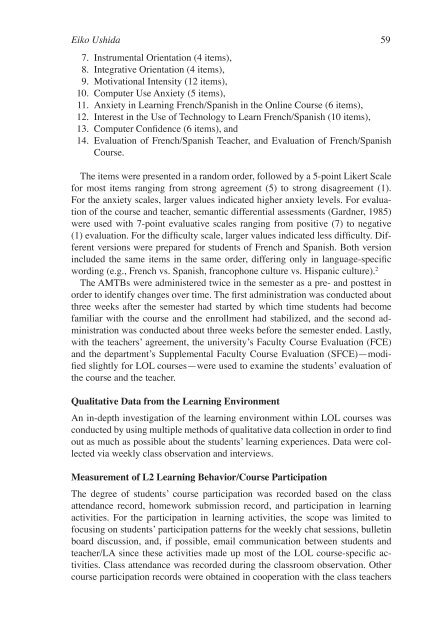The Role of Students' Attitudes and Motivation in Second ... - CALICO
The Role of Students' Attitudes and Motivation in Second ... - CALICO
The Role of Students' Attitudes and Motivation in Second ... - CALICO
You also want an ePaper? Increase the reach of your titles
YUMPU automatically turns print PDFs into web optimized ePapers that Google loves.
Eiko Ushida 59<br />
7. Instrumental Orientation (4 items),<br />
8. Integrative Orientation (4 items),<br />
9. <strong>Motivation</strong>al Intensity (12 items),<br />
10. Computer Use Anxiety (5 items),<br />
11. Anxiety <strong>in</strong> Learn<strong>in</strong>g French/Spanish <strong>in</strong> the Onl<strong>in</strong>e Course (6 items),<br />
12. Interest <strong>in</strong> the Use <strong>of</strong> Technology to Learn French/Spanish (10 items),<br />
13. Computer Confidence (6 items), <strong>and</strong><br />
14. Evaluation <strong>of</strong> French/Spanish Teacher, <strong>and</strong> Evaluation <strong>of</strong> French/Spanish<br />
Course.<br />
<strong>The</strong> items were presented <strong>in</strong> a r<strong>and</strong>om order, followed by a 5-po<strong>in</strong>t Likert Scale<br />
for most items rang<strong>in</strong>g from strong agreement (5) to strong disagreement (1).<br />
For the anxiety scales, larger values <strong>in</strong>dicated higher anxiety levels. For evaluation<br />
<strong>of</strong> the course <strong>and</strong> teacher, semantic differential assessments (Gardner, 1985)<br />
were used with 7-po<strong>in</strong>t evaluative scales rang<strong>in</strong>g from positive (7) to negative<br />
(1) evaluation. For the difficulty scale, larger values <strong>in</strong>dicated less difficulty. Different<br />
versions were prepared for students <strong>of</strong> French <strong>and</strong> Spanish. Both version<br />
<strong>in</strong>cluded the same items <strong>in</strong> the same order, differ<strong>in</strong>g only <strong>in</strong> language-specific<br />
word<strong>in</strong>g (e.g., French vs. Spanish, francophone culture vs. Hispanic culture). 2<br />
<strong>The</strong> AMTBs were adm<strong>in</strong>istered twice <strong>in</strong> the semester as a pre- <strong>and</strong> posttest <strong>in</strong><br />
order to identify changes over time. <strong>The</strong> first adm<strong>in</strong>istration was conducted about<br />
three weeks after the semester had started by which time students had become<br />
familiar with the course <strong>and</strong> the enrollment had stabilized, <strong>and</strong> the second adm<strong>in</strong>istration<br />
was conducted about three weeks before the semester ended. Lastly,<br />
with the teachers’ agreement, the university’s Faculty Course Evaluation (FCE)<br />
<strong>and</strong> the department’s Supplemental Faculty Course Evaluation (SFCE)—modified<br />
slightly for LOL courses—were used to exam<strong>in</strong>e the students’ evaluation <strong>of</strong><br />
the course <strong>and</strong> the teacher.<br />
Qualitative Data from the Learn<strong>in</strong>g Environment<br />
An <strong>in</strong>-depth <strong>in</strong>vestigation <strong>of</strong> the learn<strong>in</strong>g environment with<strong>in</strong> LOL courses was<br />
conducted by us<strong>in</strong>g multiple methods <strong>of</strong> qualitative data collection <strong>in</strong> order to f<strong>in</strong>d<br />
out as much as possible about the students’ learn<strong>in</strong>g experiences. Data were collected<br />
via weekly class observation <strong>and</strong> <strong>in</strong>terviews.<br />
Measurement <strong>of</strong> L2 Learn<strong>in</strong>g Behavior/Course Participation<br />
<strong>The</strong> degree <strong>of</strong> students’ course participation was recorded based on the class<br />
attendance record, homework submission record, <strong>and</strong> participation <strong>in</strong> learn<strong>in</strong>g<br />
activities. For the participation <strong>in</strong> learn<strong>in</strong>g activities, the scope was limited to<br />
focus<strong>in</strong>g on students’ participation patterns for the weekly chat sessions, bullet<strong>in</strong><br />
board discussion, <strong>and</strong>, if possible, email communication between students <strong>and</strong><br />
teacher/LA s<strong>in</strong>ce these activities made up most <strong>of</strong> the LOL course-specific activities.<br />
Class attendance was recorded dur<strong>in</strong>g the classroom observation. Other<br />
course participation records were obta<strong>in</strong>ed <strong>in</strong> cooperation with the class teachers
















